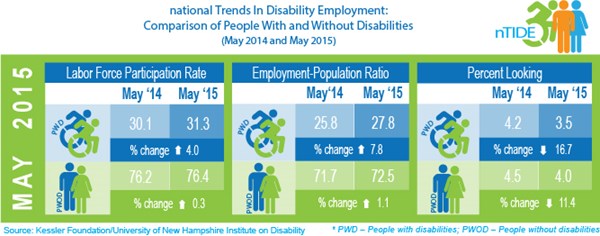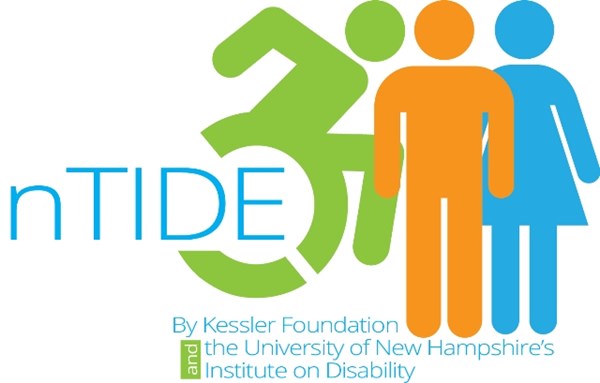WEST ORANGE, N.J., June 5, 2015 (GLOBE NEWSWIRE) -- The economy continues to grow as more Americans with and without disabilities enter the workforce, according to today's National Trends in Disability Employment – Monthly Update (nTIDE), issued by Kessler Foundation and University of New Hampshire's Institute on Disability (UNH-IOD). A recent survey shows that people with disabilities are striving to enter the workforce and seeking more hours.
In the Bureau of Labor Statistics' Jobs Report released Friday, June 5, the employment-to-population ratio for working-age people with disabilities increased from 25.8 percent in June 2014 to 27.8 percent in June 2015 (up 7.8 percent; 2.0 percentage points). For working-age people without disabilities, the employment-to-population ratio also increased slightly from 71.7 percent in June 2014 to 72.5 percent in June 2015 (up 1.1 percent; 0.8 percentage points). The employment-to-population ratio, a key indicator, reflects the percentage of people who are working relative to the total population (the number of people working divided by the number of people in the total population multiplied by 100). In comparison to June 2014, 430,000 more Americans with disabilities are in the workforce.
"We have seen more Americans with disabilities becoming employed over the past eight months, relative to the same months in the previous year," according to John O'Neill, Ph.D., director of employment and disability research at Kessler Foundation. "Most notably, the gains for people with disabilities have outstripped the gains made by people without disabilities. This continued good news is qualified by the fact that there remains an employment gap of 44.7 percent between people with and without disabilities." (The employment gap is the difference in the employment-to-population ratios between people with and without disabilities.)
For people with disabilities, the labor force participation rate also increased from 30.1 percent in June 2014 to 31.3 percent in June 2015 (up 4.0 percent; 1.2 percentage points). For people without disabilities, the labor force participation rate increased slightly from 76.2 percent in June 2014 to 76.4 percent in June 2015 (up 0.3 percent; 0.2 percentage points). The labor force participation rate is the percentage of the population that is working or actively looking for work.
"Growth in employment for both people with and without disabilities has been pretty positive over the past few months, although moreso for people with disabilities, which is the first time I have ever seen this occur in a sustained fashion," said Andrew J. Houtenville, Ph.D., associate professor of economics and research director at UNH-IOD.
The 2015 Kessler Foundation National Employment and Disability Survey, the first nationally representative survey to examine the workplace experiences of people with disabilities, was released on June 3. The survey was commissioned by Kessler Foundation and conducted by the University of New Hampshire.
The survey of 3,013 adults showed that 68 percent of Americans with disabilities are striving to work, including those who are working, preparing for employment, looking for jobs, seeking more hour, and overcoming barriers to employment. Those with jobs work an average of 35.5 hours per week, with 60.7 percent working more than 40 hours per week. A substantial number of those surveyed reported overcoming barriers. The top three barriers to finding work were lack of education or training, the employers' assumption that they couldn't do the job and lack of transportation. In the workplace, the top three barriers were getting less pay than others in similar jobs, negative attitudes of supervisors and negative attitudes of coworkers. To view the full results, visit https://kesslerfoundation.org/kfsurvey15.
"The Kessler Foundation Employment Survey proves that Americans with disabilities want to work and are ready and able to enter the workforce," said Rodger DeRose, president and chief executive officer of Kessler Foundation. "The survey is also the first to reveal successful strategies that these individuals used to obtain and maintain employment. We expect that policymakers and leaders in the disability field will find the survey useful in developing programs that expand employment opportunities for people with disabilities."
In June 2015, among workers ages 16-64, the 4,406,000 workers with disabilities represented 3.1 percent of the total 140,804,000 workers in the U.S.
"The statistics in nTIDE are not seasonally adjusted," noted Dr. O'Neill. "Because disability employment data have been collected for so few years, more time is needed for seasonal trends to become evident."
The next nTIDE will be issued on Thursday, July 2, 2015.
NOTE: The statistics in the National Trends in Disability Employment – Update are based on Bureau of Labor Statistics numbers, but are NOT identical. They have been customized by the University of New Hampshire to efficiently combine the statistics for men and women of working age (16 to 64).
nTIDE is funded, in part, by grants from the National Institute on Disability, Independent Living and Rehabilitation Research (NIDILRR) (H133B130015 & H133B120005) and Kessler Foundation.
About Kessler Foundation
Kessler Foundation, a major nonprofit organization in the field of disability, is a global leader in rehabilitation research that seeks to improve cognition, mobility and long-term outcomes, including employment, for people with neurological disabilities caused by diseases and injuries of the brain and spinal cord. Kessler Foundation leads the nation in funding innovative programs that expand opportunities for employment for people with disabilities. For more information, visit KesslerFoundation.org.
About the Institute on Disability at the University of New Hampshire
The Institute on Disability (IOD) at the University of New Hampshire (UNH) was established in 1987 to provide a coherent university-based focus for the improvement of knowledge, policies, and practices related to the lives of persons with disabilities and their families. For information on the NIDILRR-funded Employment Policy and Measurement Rehabilitation Research and Training Center, visit http://www.ResearchonDisability.org.
For more information, or to interview an expert, contact:
Lauren Scrivo, 973.768.6583, LScrivo@KesslerFoundation.org
Carolann Murphy, 973.324.8382, CMurphy@KesslerFoundation.org
Photos accompanying this release are available at:

